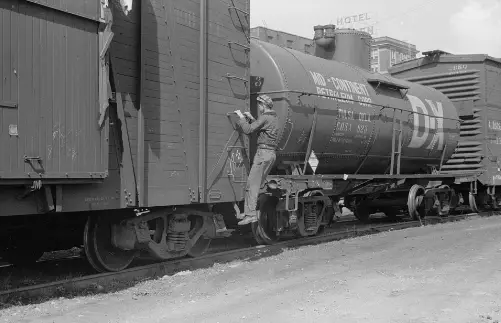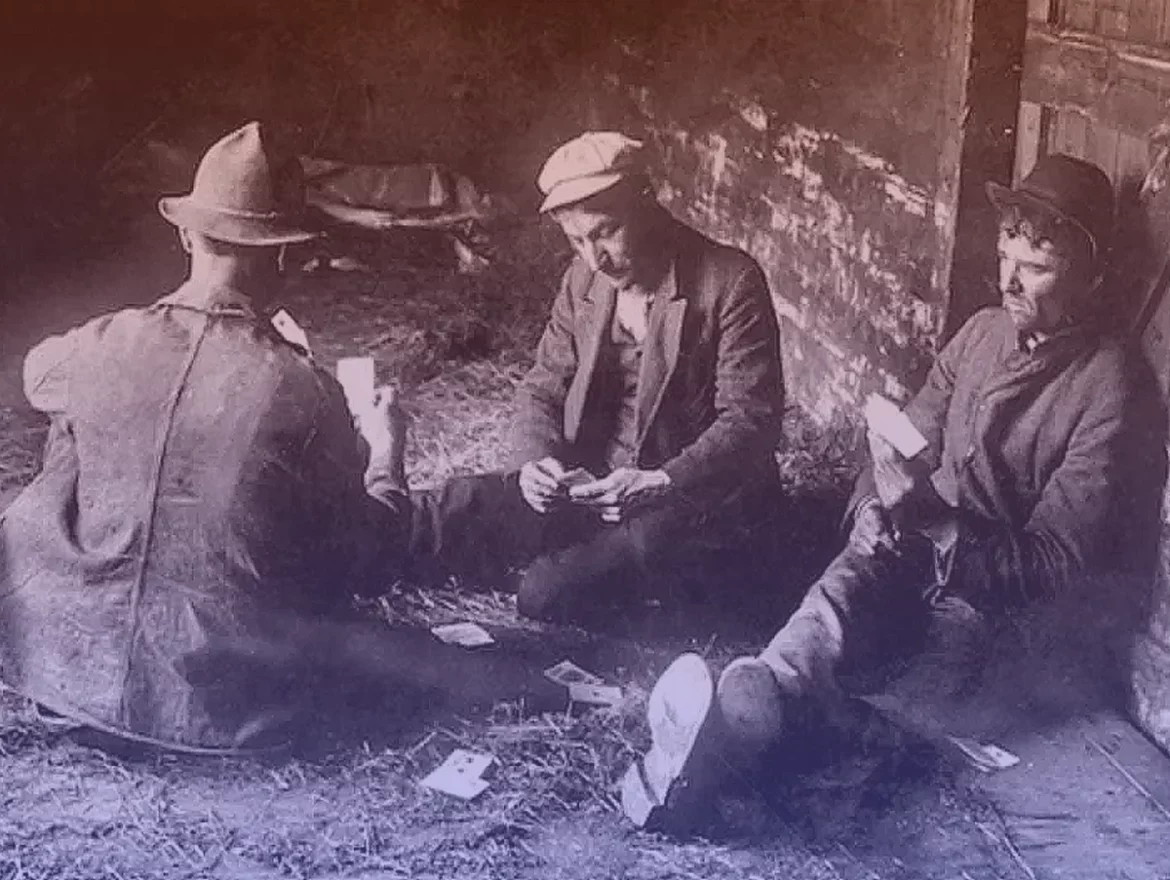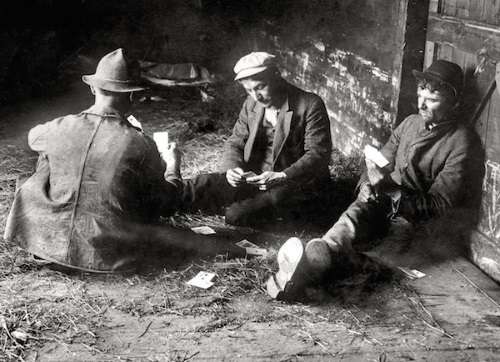So many tramps rode the rails into Massachusetts after the Civil War that in 1899 a group of charity administrators published a manual, The Best Methods of Dealing with Tramps and Wayfarers.
Most tramps had no home or job. They wandered from place to place, riding on freight cars, sleeping in barns or station houses and turning up in a city. There they stayed long enough to get money to push on farther – or to get arrested. Some took to the road looking for work, but most avoided labor like the plague.
Connecticut can claim the most famous tramp of all: the Leatherman, who as his name suggests, dressed entirely in handmade leather. Every year from 1857 to 1889 he walked a 360-mile circuit between the Hudson and Connecticut rivers, starting and ending in Danbury.
But the magnet for tramps was Massachusetts.
In 1899, Massachusetts recorded 207,081 cases of vagrancy.
“This is the great State of the country among the tramps,” said an undercover operative in 1895 who traveled with tramps. “They are better treated in Massachusetts than in any other State of the Union.”
Tramps
They had names, or monicas, like Connecticut Slim, Shorty and Boston Blackey. They traveled with timetables and maps, sleeping in railroad boxcars or shanties in good weather, seeking shelter in police stations when the weather turned crimpy. Tramps usually didn’t like to talk about their past, but they could tell tall tales and they swapped information about places to go.
They may have been bums, but they weren’t stupid. Tramps knew the laws of every state they visited, and how to avoid arrest. They knew which farmer’s wife would feed them when they knocked on her back door, and they knew the good ‘chewing’ towns from the bad.
Charles Ralston of the Hoosac Valley News said for six months his wife fed every tramp who came to the door. Three tramps came by their home in the first month, six in the second, 18 in the third and one a day in the sixth. Then they stopped feeding the tramps, and their visits dropped off.
The tramps communicated with a system of markings they’d write with chalk or a jackknife. They marked fences, buildings, trees, pavements — anywhere another tramp might find it. A zigzag, for example, meant a barking dog. A cat meant a kind lady. Three diagonal lines meant danger.
Philosophical
In 1899, the eminent physician Francis Weld Peabody described the tramp with grudging respect:
He is often an exceptionally acute, observant, somewhat philosophical character. There is something picturesque and even dramatic about a man who in the midst of a world of work can be perfectly free from the trammels of industry, and live — like a professor — by his wits.
The famous detective Allan Pinkerton in 1877 called them ‘persons of great natural gifts, close observers of people and things, keen to secure and retain valuable information, quick to discern motives for human action, splendid conversationalists, and, as a rule, also persons of superior education.’
The Rise of the Tramp
The lifestyle that Roger Miller sang about in his 1964 hit, King of the Road, took hold in the United States after the Civil War. Recession and the railroads gave it a boost.
Pinkerton blamed the war for the hordes of vagabonds roaming the country. “Hundreds upon hundreds became demoralized by the lazy habits of camp-life, and were suddenly turned loose upon society without any regular employment, or desire for any,” he wrote in 1877.
Some Civil War veterans, undoubtedly, took to the vagabond life because of trauma sustained during the conflict.
Railroads, especially slow-moving freight trains, enabled tramps to travel far and wide for nothing. In 1899, Jacob Riis, a social reformer who had tramped himself, attributed, ‘the great increase in facility of cheap travel, by which a man may come from the interior of Russia for less money than it cost our grandfathers to travel to New York.’
The Long Depression of 1873-79 caused the number of tramps to spike. In 1874, Boston reported 98,263 cases of vagrancy, triple the number just two years earlier. (The city’s population was then about 250,000, but tramps could be counted more than once.)
Twenty years later the Panic of 1893 and the four-year depression that followed caused another uptick in vagrancy. Jack London quit his job in disgust in 1893 and took to the road, later writing about it.

Jack London
In 1895, T.T. Pomeroy of the Central Labor Union told the Massachusetts Board to Investigate the Subject of the Unemployed that many men had taken to tramping in the previous year. Of those, many were shoemakers.
“Lots of them …were regarded as skilled laborers,” he said. “Perhaps not the most efficient, but men who were fairly comfortable, pleasant companions, rather easy going and perhaps careless, fair hands in ordinary conditions.”
Dover Deals With Tramps
They may have been entertaining, even pleasant, but the tramps caused problems in Massachusetts cities and towns.
In 1889, the town of Dover put up 972 tramps. A local resident received 25 cents to feed and shelter each tramp, but he was to give them nothing more than crackers and water. Selectmen suspected he gave them more. He also gave them a comfortable room and the daily newspapers, which they could read by a lamp he kept lit.
One night a police officer in nearby Milford found a book belonging to a tramp that had all the names of the Massachusetts cities and towns in them. Some had an x next to them, and some had xx. The policeman asked what it meant. The tramp said x meant a good town, xx meant a damned good town.
Dover had two xx’s. So the town built two brick cells in the town hall cellar and wooden platforms for tramps to sleep on. The next year, Dover only put up 10 tramps.
Paradise
In general, Massachusetts treated tramps better than neighboring states. In the 1890s, Providence crammed 65 tramps in a room 13 feet long. New Hampshire made tramping illegal in 1878 and rigidly enforced the law for several years. It kept the tramps out of the state for a few years, but then they relaxed enforcement and the tramps drifted back.
In Massachusetts, a tramp could get lodging for two nights in most towns, usually in the police station. Five out of six gave tramps food, even if it was just crackers and water. A tramp could easily spend 100 days in Massachusetts without going to jail.
Many stayed in the small towns along the southern border, guests of farmers who fed them, took away their matches and let them sleep in the barn.
Even jail wasn’t so bad in winter. Though tramps stayed away from the Fitchburg and Worcester jails, they liked the Reformatory in Concord. And when a judge discovered some tramps were glad to go to Bridgewater State Prison for three months, he stopped sending them there.
Travel Patterns
Many came from Pennsylvania, New York, Connecticut and Rhode Island, according to the undercover operative. He categorized three kinds of tramp: town bums, shovel bums and hobos. The town bums started off in Boston and took the Fitchburg Rail Road to the Connecticut River, stopping at good chewing towns along the way. They’d take in Springfield, maybe Pittsfield and North Adams, and then go back down over the Albany railroad to Boston.

Hopping a freight train, 1940. Photo courtesy Library of Congress.
Shovel bums were men who worked for a few weeks or months, perhaps on sewers and roads. Some drove cattle in Brighton, then rode the cattle trains to the stockyards in Watertown. Many worked in the Washington mill in Lawrence. The shovel bums spent money as quick as they got it.
Some tramps were dangerous thieves, according to the undercover tramp. He called them hoboes. They avoided police stations and taught poor boys to beg and steal. Others, though, described hoboes as migrant workers – a man who lost his job and rode the rails to find work.
Work
Work would cure the tramp, according to reformers, town officers and charity administrators. But the tramp didn’t want to be cured.
The Springfield newspaper printed a rumor that Chicopee had set up a woodyard, where tramps would have to saw wood to earn their keep. The number of tramps visiting Chicopee fell from about 30 a night to about seven. They returned to Chicopee when they learned the woodyard was a hoax.
Grafton tried to make the tramps break stone, but they broke so many sledge hammers the town lost money. Leominster had them break stone in exchange for food, and it kept them out of town.
That wouldn’t have surprised Jacob Riis. He wrote,
I have once been “on the road” myself, and I know that there is an insidious poison in the tramp’s life that saps the energy of the man, until in a very little while he does not care for anything, so long as he can fill his belly and lie and bask in the sun.
This story was updated in 2024.



2 comments
My father called them Hobo’s. 1958, coming home from visiting my Grandparent in Chelsea, heading to our triple decker in Dorchester, on a Saturday night. As we passed an architectural salvage yard with a chained linked fence, there were three hobo’s around a burn barrel warming their hands, always the same three men.,In the back of the property. Every Saturday for years, my father would say “There they are”! My Father was a WW2 Purple Heart vet. And by his tone of voice, he seemed upset that they did not have a job. As a 10 yrs old I understood. My Dad was promised his job would be there when he came back from Normandy, but it wasn’t . He always worked so hard. I was proud of him. They truly were The Greatest Generation ! they never gave up. My mother would say “we did what we had to do”. Just part of our life.
Wonderful story, Mary!
Comments are closed.